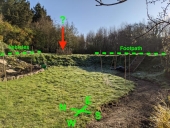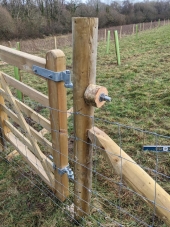
 1
1




 2
2




Small-holding, coppice and grassland management on a 16-acre site.
 2
2








 2
2




 1
1




Luke Mitchell wrote:Nice garden and nice illustrations - they make it very easy to understand your problem and requirements.
It sounds as though your main objective is to exclude rabbits, is that correct? Do you also have deer that come into your garden to eat your veggies? What about badgers? They have been known to cause havok too.
You could consider planting a hedge and then fencing alone one side of it. If you fenced along the inside this would lessen the visual impact of the fence significantly. The downside of this approach is that the fence doesn't serve to protect the sapling hedge and you might need to use tree guards (I don't recommend these unless absolutely necessary) or another, temporary fence on the outside.
The separate hedge and fence would allow you to repair or replace the fence without affecting the hedge planting. The hedge becomes a wildlife habitat and a potential yield (damsons, sloes, blackberries, crab apples, rose, wood for crafting and fuel) and the fence a barrier to keep it away from your tender plants. You could also consider laying the hedge eventually, once it reaches 6-8' high, which would thicken it up (and possibly act as some deer protection*, though they might just jump it) and reduce the height to let in more light. I personally love the look of a laid hedge.
Good-quality chestnut fence posts are a good idea. You will have to replace them eventually - from what I've heard 20 years sounds like an accurate guess - but they will last much longer than the horrible, pressure-treated softwood posts. Old, oak heartwood fence posts seem to last much longer than that but I suspect that they are cripplingly expensive, if available at all. Another option would be to scorch the ends of your posts and soak them in oil (nasty old engine oil is supposed to be very effective but I don't think this is environmentally sound, nor a good idea near an edible garden).
To make life easier, you could lay the fencing along the ground for 2' before it becomes the vertical fence. This is often used when fencing chicken enclosures and foxes can't dig underneath it. I suspect that it would stop most other critters too.
* I've heard that parallel hedges, fences, or a mixture of both will prevent deer from crossing a boundary as they don't like landing in narrow places.
 1
1




Casie Becker wrote:Actually I do have a question about the digging abilities of the rabbits. If you dug a trench and filled it with large rubble (I'd have enough limestone for the purpose but old broken cement, bricks, tiles and such would probably also fit my question) would a rabbit dig through that if there wasn't a wire? If not maybe you could put a French drain style rabbit barrier that would also help drain water away from your fence faster at the same time.
Sorry about the flood of posts. For some reason your problem caught my imagination this morning.








John Daley Bendigo, Australia The Enemy of progress is the hope of a perfect plan
Benefits of rainfall collection https://permies.com/t/88043/benefits-rainfall-collection
GOOD DEBT/ BAD DEBT https://permies.com/t/179218/mortgages-good-debt-bad-debt
 1
1




Small-holding, coppice and grassland management on a 16-acre site.




Luke Mitchell wrote:I'm curious to know whether steel fencing outlasts durable timber by enough of a margin to be worth the extra costs? I'm talking about financial and environmental. I confess that I have no idea how long a decent metal fence would last but I do know that I've seen my fair share of rusty farm gates.
The modern, galvanised ones seem to fail much more quickly than the old, wrought iron fences and gates that you sometimes see. Perhaps they were treated more kindly, given a coat of enamel paint every so often. I imagine modern equivalents would be very costly, if available.
My other thought is that the embodied energy in a metal fence far exceeds that of a timber one. Chestnut posts will have been coppiced, likely in Kent (at least for UK stock), and so represent a sustainable carbon sink. The processing is minimal, just sawing to length and pointing. Some posts will have been split/cleft too. The list of processes required to extract, produce and transport a galvanised fence post are too long to bother listing but they require a lot of oil products, coal for smelting and heavy metals for the galvanising process.
Have you got a quote for the various options you are considering, Mj? I have costed up sheep mesh + chestnut post fences for our land and it isn't cheap. Your site looks fairly small though and I'd be surprised if the materials ran to more than £300. Each 1.8m post will cost you about £5.50, plus delivery. You can space these every 3m or so, with a larger post for the corners.
I do like the idea of a rubble-filled trench as a bunny barrier. I'm sure you could obtain rubble/hardcore for free if you spent a bit of time searching. Alternatively, natural stone is pretty cheap (I have paid £10/1000kg incl. delivery). An extension of this idea, which would surely be the most expensive option of the lot, is to build a stone wall that sits a foot or more down into the ground. You may be able to source wall stone for free too - in South Wales, where I used to live, it was often available as people pulled down outside toilets or old walls, free for the collector. Depending on your local climate and availability of clay you could also consider a limed cob wall (with an overhanging eave) - but this wouldn't last in a flood event.
 3
3




Small-holding, coppice and grassland management on a 16-acre site.




![Filename: download-20.jpg
Description: [Thumbnail for download-20.jpg]](/t/184211/a/181168/download-20.jpg)
![Filename: download-19.jpg
Description: [Thumbnail for download-19.jpg]](/t/184211/a/181169/download-19.jpg)
John Daley Bendigo, Australia The Enemy of progress is the hope of a perfect plan
Benefits of rainfall collection https://permies.com/t/88043/benefits-rainfall-collection
GOOD DEBT/ BAD DEBT https://permies.com/t/179218/mortgages-good-debt-bad-debt
 4
4





|
Bring me the box labeled "thinking cap" ... and then read this tiny ad:
Play Your Way to a Sustainable Lifestyle: Uncover Permaculture Principles with Each Card
https://gardener-gift.com/
|






